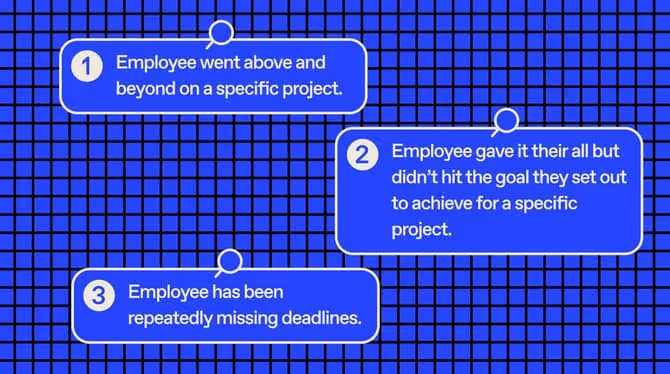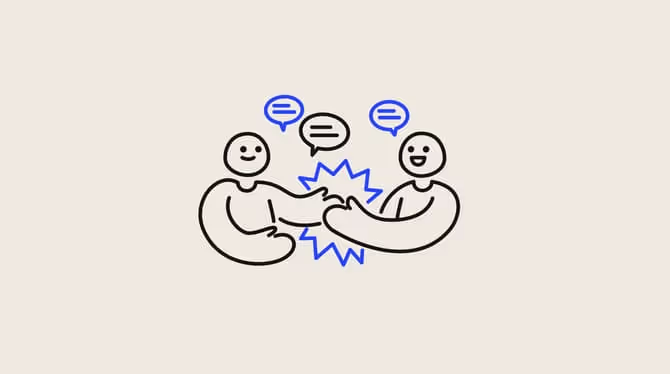15 performance management feedback examples to use in your next review

Discover Workleap Officevibe's benchmark report on 12 key employee engagement metrics

Modern performance management is all about agility and continuous improvement — where feedback is at the center. However, feedback can make or break the bank of employee motivation and performance. So what's the magic formula?
This article is your guide to mastering the art of continuous feedback — a tool that fuels employee engagement, team synergy, and growth.
The importance of feedback within continuous performance management
Regular and constructive feedback is the backbone of a company's performance management practices. It isn't just a routine check-in. It's a continuous conversation that empowers employees to perform at their best. It's a tool that enables managers to be agile and make better decisions based on the insights it reveals.
Unlike more traditional models of performance management, feedback in a continuous agile system allows managers to intervene and employees to flag concerns at need, rather than wait for the next performance review to be able to connect.
From driving productivity to keeping everyone on the same page, continuous feedback provides clarity and support, ensuring employees know their strengths, areas of improvement, and the next steps they need to take.
{emphasize}What is continuous performance management?
Continuous performance management is a dynamic approach where managers and employees adapt performance activities to changing circumstances, in real-time, while staying aligned to overarching goals.{emphasize}
7 ways feedback helps improve employee performance
Feedback can be a game changer for individual employees and teams alike. Whether positive or constructive, the point of feedback is to support performance and move things toward successful outcomes during and between performance reviews. Here's how:
1. Increased professional (and personal) confidence
Positive feedback isn't just a pat on the back — it can boost an employee's confidence big time. When people receive recognition for their achievements, it reinforces their belief in their own abilities, which can lead to even more confident and effective performance. In essence, positive feedback is positive reinforcement.
2. Enhanced skills and knowledge
Without feedback, employees have to no way to know if they're on the right path or way off. Feedback is the gateway to growth and skill development, as it provides an opportunity for managers to suggest training, mentorship, or resources that can help employees acquire the necessary skills and knowledge to excel. And if the feedback is continuous, so is the improvement.
3. Increased adaptability
The workplace is constantly changing — whether it's with new technology, processes, or management methods. Feedback helps employees navigate these changes, as a key part of transparent communication and support, ensuring employees remain flexible and ready for whatever comes their way.
4. Quicker behavioral changes
Addressing specific behaviors or habits that need adjustment through employee feedback is the quickest way to course-correct. It helps nip things in the bud before little red flags become serious problems. This could be gaps in punctuality or time management skills. Thanks to pinpointed feedback, employees can make swift, effective changes that are necessary to perform well.
5. Better alignment with organizational objectives
Linking an employee's work to the broader organizational goals is a powerful motivator for improvement. It helps them see the connection between their performance and the success of the company, and understand the value of their impact. Feedback serves as the connective tissue, communicating the correlation between an employee's actions and results.
6. Heightened innovation and creativity
Constructive feedback is the muse for confidence and innovation. It can encourage employees to think outside the box and find creative solutions to any challenge. Feedback serves a culture of open communication, which fosters an environment where employees feel safe enough to share their ideas and try new things. This leads to improved performance through new approaches.
7. Faster conflict resolution
There's almost nothing as unproductive as tension between colleagues. Addressing interpersonal conflict head-on prevents good vibes from taking a hit and tanking team spirit. Feedback helps employees develop strategies for resolving issues, improving their relationships with each other, as well as improving teamwork and overall performance.
Feedback delivery best practices
Feedback is at the heart of growth and performance improvement. But there is an art to it. Managers have the crucial responsibility to deliver effective performance feedback to see positive changes. Whether given during a performance review or an in-between check-in, here are best practices for delivering feedback with impact:
Be timely
When it comes to impactful feedback, the clock is always ticking. Managers recognize there's a certain window of time to provide feedback for it to be relevant and most effective. It's important to provide feedback as close to the observed behavior or performance concern as possible, rather than rely on performance reviews to be the only opportunity for conversation. Swift feedback not only keeps the details fresh in the employee's mind but also allows for immediate improvement, preventing further performance issues from continuing.
Timeliness is just as important for positive feedback too. When managers acknowledge accomplishments when they occur, employees feel recognized. Delaying on recognition may leave an employee feeling like their efforts are overlooked and underappreciated.
Focus on behavior and results
As with all effective communication, feedback needs to be clear and specific. Impactful feedback is objective, addressing specific behaviors and outcomes, rather than personality traits. Managers should stick to observable and measurable actions, which then gives employees something concrete to work off of. This is why KPIs are helpful reference points during feedback — it's about the numbers, not the nuances.
Stay objective
Elaborating on the above point, great feedback maintains an unwavering commitment to objectivity. This means that feedback should be free from bias or personal judgments, and based on facts and evidence. Managers should avoid making assumptions or sharing their performance appraisal comments based off of emotions.
Objectivity is important to maintain throughout the entire performance review process. It sets the tone for constructive dialogue and fair, unbiased evaluations along the employee journey.
Use the "sandwich" approach sparingly
The sandwich method is a great communication technique — especially for feedback conversations. Managers start with praise, deliver the feedback, and then end with praise. The idea is to cushion less-than-positive comments between positive reinforcement to help employees not lose motivation as they look to improve their performance.
While the "compliment-critique-compliment" method can be very effective, it's important to use it only when appropriate. Directness is key when delivering feedback, and diluting the main message may obscure an employee's necessary course of action. Managers need to choose reinforcement moments wisely — they have to be genuine and complement the overall feedback.
Be specific
Ambiguity is one of the top killers of effective feedback. If employees feel unclear as to what managers are trying to tell them, they can't understand what aspects of their performance need improvement or what steps need to be taken. For feedback to be effective, managers need to provide concrete examples and details to illustrate their points.
Offer solutions — or brainstorm them together
A manager's role extends beyond highlighting problems — it's also about supporting employees in their performance. Whenever possible, they should suggest practical solutions or steps for improvement within feedback moments. Otherwise, employees might be left hanging, and unclear on how to improve.
Sometimes, two brains are better than one — problem-solving can also involve collaboration. Why not transform a performance review into a shared brainstorming session? Not only does this help uncover realistic solutions but it demonstrates a manager's commitment to helping their employees learn and grow. This can really strengthen the employee-manager relationship, and motivate the employee even more by feeling supported.
Create a safe space
Being on the receiving end of feedback is a vulnerable position. An effective performance review or feedback session occurs in a safe and private environment where employees can openly discuss their performance without fear of judgment. This paves the way for constructive conversations.
Remember, feedback isn't about pointing fingers. Active listening, role-play, and self-reflection are great strategies for managers to develop empathy and meet the employees at their level.
Listen actively
It's also important for managers to offer an attentive ear and undivided attention during feedback sessions. After all, feedback is an exchange, and listening is just as important as speaking. Being a good listener is an essential skill for managers to have.
Allowing employees to respond to feedback, ask questions, seek clarification, and even give feedback on the feedback itself, lets the employees know that their perspective is valued and respected during their performance review.
Use "I" statements
In the art of feedback, personal ownership matters. When providing feedback, it's key for managers to express their observations and feelings using "I" statements.
{highlight}For example, saying "I noticed that...," rather than "You always..." avoids creating generalizations and or an environment of blame, and instead creates an atmosphere of understanding.{highlight}
Be constructive, not destructive
The goal of feedback is to help improve performance, not to tear down an employee. Constructive feedback keeps the focus on how an employee can do better rather than just highlighting what was done wrong.
It's important for employees not to dwell on shortcomings and be empowered to take charge of their growth and development. Managers need to steer all performance review conversations towards positive change. Onwards and upwards!
Tailor your approach
Delivery is everything. And different employees might respond to different feedback delivery styles. Recognizing individuality is important for managers to adapt their methods to the unique needs and preferences of each employee. Some employees prefer a straightforward approach, while some might need more "sandwiching". Some employees thrive by diving straight into the next steps, while some might do better with more hindsight analysis to connect the dots on what to improve.
{emphasize}Your continious performance management starter pack
Jumpstart your way to improvement with our free continuous performance management starter pack! A turnkey solution packed with best practices, a performance cycle action plan, a goal-setting worksheet, and sample agendas to help you map out every performance checkpoint.{emphasize}
15 performance review phrases for positive, negative, and constructive feedback
Now, the crux of this article: Performance review phrases to help shape your own feedback around. Here, you'll find examples of different feedback, from positive to negative to constructive.
As with performance management best practices, these performance review phrases serve as templates — the key is to personalize and expand them, as feedback should be tailored to fit the unique needs of each employee performance review.
Positive performance review phrases
Positive feedback is the source of employee engagement, confidence, and motivation. It's a strategic tool that reinforces positive behaviors, making employees feel appreciated and valued, and fosters a culture of recognition.
Scenario 1: When an employee has gone above and beyond on a specific project or task
{emphasize}Feedback example: "I just wanted to give you a big shoutout for the fantastic job you did on [specific project/task]. Your dedication and hard work really stood out, and I couldn't be happier with the results. Your efforts are greatly appreciated, and I'm here to help you succeed in future projects. Keep it up!"{emphasize}
Positive performance review phrases like the above show employees that you value their extra efforts, which help drive the company's success and well-being, and encourage them to aim to exceed expectations.
Scenario 2: When an employee successfully leads a challenging project
{emphasize}Feedback example: "Leading the cross-functional team on [specific project] was no small feat, and you handled it with tremendous skill. I wanted to commend your leadership and how you helped other team members navigate the ups and downs to get it delivered. You demonstrate great potential to take on more leadership responsibilities in the future, and I'd love to support you in that if that's something you're interested in."{emphasize}
This positive employee feedback example shows employees that you take notice of leadership wins, and appreciate their contribution to team success.
Scenario 3: When an employee demonstrates exceptional problem-solving ability
{emphasize}Feedback example: "I've noticed the way you tackle problems head-on and I am impressed. It's been a game-changer for the team. When [specific issue] required a strategy, you delivered. You should be proud of your problem-solving skills, as they're a tremendous asset to our success. Keep up the great work, we're lucky to have you!"{emphasize}
This positive employee feedback example shows employees that their tactical or strategic skills don't go unnoticed, and tie into helping achieve overall company objectives.
Scenario 4: When an employee took the initiative to improve a process
{emphasize}Feedback Example: "I noticed how you took the initiative to improve [specific process]. It's had a big impact on our team flow, but what impressed me even more was how proactive you were in identifying that there was a problem and solving it! You've stepped up as a great example for the rest of the team, and I appreciate your commitment to continuously improving how we work. Let's keep working together to make our processes even better!"{emphasize}
Positive performance review phrases like the above remind employees that when they step up, their initiative is rewarded. It further nurtures a culture that values proactiveness.
Scenario 5: When an employee consistently provides support to other team members
{emphasize}Feedback example: "I have to say, you've been a huge help recently with [specific example] and [specific example]. As teammates, it's a given that we help each other, but I've noticed you go above and beyond to assist your peers. Your willingness to lend a hand to other team members, and share your knowledge, as well as your teaching skills, has really shined. I'm here to help you step into mentorship opportunities if that's something that sounds up your alley."{emphasize}
This positive employee feedback example highlights a culture of collaboration, and that certain abilities are not only recognized but nurtured to help employees progress in their careers.
Constructive performance review phrases
The objective of constructive feedback is to recognize an employee's contribution while also highlighting areas of improvement — be it about communication skills or time management. For feedback to be constructive, it must frame things so employees understand how improvement will serve them and their team.
Scenario 6: When an employee gave it their all in a project but didn't hit the goal they set out to achieve
{emphasize}Feedback example: "I do not doubt your dedication to the [specific project], and your hard work and efforts have been commendable. While you didn't hit the goal(s) we initially set, like with [specific goal], I feel there's loads of learning potential here to hit a home run next time. Let's chat about what went well, and what could've been better, and figure out a strategy together for when you take on new projects. Your work here is really valuable, and I'm here to make sure you can achieve even more success!"{emphasize}
Performance review phrases like this one communicate that even if employees don't quite hit the mark, their efforts are still appreciated and they can feel reassured that their manager is there to help them improve.
Scenario 7: When an employee demonstrated strong leadership skills but didn't properly delegate tasks
{emphasize}Feedback example: "I really appreciate your leadership on [specific project]. There's no doubt about your strengths. Although, I feel there's room for growth in some specific areas, like delegation, and I'm here to help you work on that. For example, [specific example] could've gone better to avoid [related concern]. Let's take some time to discuss a few strategies to improve your delegation skills. Your leadership potential is something worth nurturing, and I have no doubt that if we refine this key aspect you'll be taking charge flawlessly."{emphasize}
This feedback example sandwiches constructive criticism between praise and encouragement so that employees can understand that improvements are opportunities for future success, not setbacks.
Scenario 8: When an employee's communication skills can be improved for greater clarity
{emphasize}Feedback example: "As you know, communication is vital for any project. I love how communicative you were on [specific project], but there were a couple of instances where clarity could've been better to avoid [related issue]. Don't worry, I've been there before. If we refine this skill, I'm confident communication will feel smoother. I have a few tips on how to be clear and concise, so let's explore ways we can help you structure and enhance your communication skills."{emphasize}
This feedback example also uses the sandwich method, making sure to include praise along with constructive criticism. It also demonstrates empathy from the manager, creating a safe environment where the employee can feel empowered in the opportunity to improve.
Scenario 9: When an employee shows promise but could use additional training
{emphasize}Feedback example: "I love how creative you were when tackling [specific task]. This really demonstrates how much potential you have to succeed. However, it made me realize that additional training in [related skill] could help you improve. Let's chat about some skill development opportunities I have in mind for you. I'm confident that the right training will do your creativity justice in the long run."{emphasize}
This constructive feedback example uses positive reinforcement and praise while steering the employee toward improvement opportunities. It communicates to them that the company sees the value in their creative solutions, and is willing to invest in their success.
Scenario 10: When an employee has provided great individual contributions but could improve on team contributions
{emphasize}Feedback example: "All your recent individual contributions to [specific project] have been valuable, so keep up the good work! That said, I'd like to encourage you to get more involved when it comes to teamwork and collaboration. When we work together instead of alone, and leverage each other's strengths, both our collective and own success shines. Let's talk about a few ways we can make sure you get more involved."{emphasize}
This constructive feedback example acknowledges current value while highlighting where more value could be unlocked. It reminds the employees of the greater picture and how they can have even more impact if they improve collaboration.
Negative performance review phrases
Not every feedback conversation is easy. Some are a little trickier and more delicate. This is the case when feedback addresses larger issues, like poor performance. While managers need to remain empathetic, it's also crucial for them to be clear on the fact that remedying these issues is non-negotiable.
Scenario 11: When an employee has been repeatedly missing deadlines
{emphasize}Feedback example: "I've noticed a pattern of missed deadlines recently, such as with [specific example] and [specific example]. As you know, meeting deadlines is critical, and this can't keep happening, so let's discuss this issue to see how we can remedy this. I want to understand the challenges you're facing so we can put in place an effective plan to improve your time management. Sounds good?"{emphasize}
By ensuring specific examples are given to back up a manager's concern, performance review phrases around a negative situation remain objective and fact-based. It also ensures that employees are reminded of company standards and that they are supported in their own improvement.
Scenario 12: When an employee's toxic attitude is affecting the team's morale
{emphasize}Feedback example: "I need to talk to you about concerns that have been raised regarding your interactions with the team. Based on peer feedback and my own observations, it's become apparent that your attitude is impacting team morale. I might not have the full picture, but I want us to have an open, one-on-one conversation about what's going on, and hear your perspective too, so we can work on this problem and agree on ways to foster a more positive team environment. Can you block your schedule one hour before the end of the day so we can address this ASAP? "{emphasize}
This negative feedback example is straightforward, objective, and prompt. It sets out the next steps to fix an attitude issue right away instead of letting it fester, while also communicating openness towards the employee's perspective.
Scenario 13: When an employee displays resistance to feedback
{emphasize}Feedback example: "Open communication is important at [company], and receiving and incorporating feedback is essential for your professional growth. As your manager, my goal is to support your improvement but I feel there's been some resistance to my feedback. This dynamic can limit your development, and I want to see you succeed. Let's take a moment to discuss the reasons behind this resistance. I will be open to your perspective, as I trust you'll be open to mine, so we can figure out a more constructive way forward together."{emphasize}
This negative feedback makes sure to show openness and willingness towards the employee, while also setting a firm tone that standards aren't being met. It also frames this improvement in direct correlation to the employee's success.
Scenario 14: When an employee struggles to adapt to change
{emphasize}Feedback example: "I know changes aren't always comfortable, but they are par of the course in the workplace. Being able to adapt is essential to succeeding in your role. I've noted a few instances where you've struggled in your ability to adapt, like when [specific example]. Let's explore what strategies we can put in place so you can develop your adaptability and have a smoother experience in the future."{emphasize}
Starting the performance review phrases with empathy helps employees receive negative feedback better and sets the tone for collaboration. Stating clear examples to back up statements also provides clarity and validity to feedback.
Scenario 15: When an employee's lack of collaboration impacts team performance
{emphasize}Feedback example: "Collaboration is fundamental to our team's success, and your limited collaboration lately has been noted. This isn't something I can ignore, as it could keep impacting our collective performance. I'd like to schedule a one-on-one with you to talk about the reasons behind this. I've witnessed your past successes, and this lack of teamwork doesn't seem like you. So let's find ways to get you back into a more collaborative spirit, which is important for me, your colleagues, and your own success."{emphasize}
Performance review phrases like the above are designed to remind employees of company standards when it comes to collaboration, while also communicating that no problem can't be fixed when we come together to find solutions.
How self-assessments supplement manager feedback
The more insights the better when it comes to well-rounded feedback. But it's not a one-way street, where feedback solely relies on a manager's point of view. Feedback is a collaborative journey, and employees play a crucial role in their own growth and development too.
Why you shouldn't skip self-assessments:
- They foster ownership and accountability: Self-assessments invite employees to reflect on their own performance. This is an important exercise that puts accountability and ownership of one's success back into their hands.
- They provide a holistic understanding of performance: Self-assessments offer an additional layer of perspective to feedback, allowing both the employee and manager to complete the picture. Pooling from employee insights might reveal important details to the story otherwise overlooked — be it root causes, additional context, or misunderstandings. This helps everyone have a more holistic view of performance.
- They help tailor performance plans: Self-assessments are powerful instruments to feed the next steps after performance reviews. Their insights reveal how to customize performance plans so they hit the nail on the head of what needs to happen for employees to improve.
- They set the foundation for a strong feedback culture: Continuous feedback is an honest, transparent, and constructive back-and-forth. Self-assessments encourage employees to take an active part in feedback giving and receiving, which feeds into a culture of communication and collaboration.
Following up after feedback: What to do after performance reviews
Let's say you've leveraged our performance review phrases, provided stellar feedback, and have just concluded a performance review meeting. Now what?
The conversation doesn't end here. On the contrary! Continuous feedback is an ongoing dialogue throughout the entire employee life cycle. After performance reviews, managers and employees both have the responsibility to keep the momentum going. Here are the key follow-up actions:
Encourage questions
After performance reviews, encourage employees to ask questions about the feedback received. Give them some time to think about it, as they might not think of questions on the spot and need some time to process the performance review. Keep the door open should they ever come back with questions — extra clarity is better than not enough.
Ask for feedback on your feedback
Sounds like a mouthful? We call this the feedback loop. Performance reviews are opportunities for everyone to learn — managers included! Just like room for questions, it's important to invite employees to give feedback on the feedback they received. They might be able to highlight what parts of the feedback have been most constructive, so you can better adapt your feedback style to them in the next round.
Set clear next steps
Thesky is the limit when it comes to the next milestones. After a performance review, define actionable steps and goals for the employee, based on the feedback. Of course, make sure these steps are realistic and appropriate. This is an exercise that should be done together, nurturing engagement and collaboration as a key part of growth and development. When employees have a clear roadmap in front of them, they're more confident and empowered in what's necessary to make progress and move forward.
Set them up for success with the right resources
To support employees in their next steps, managers also have a duty to equip them with what they need to succeed. The conversations within performance reviews should reveal materials, training, or other resources needed for employees to meet their objectives. This step is crucial — otherwise employees, no matter how willing, can only do so much without the right support.
Monitor progress
There are several ways to track an employee's progress after the improvement plan agreed upon after performance reviews. Managers can rely on different metrics, such as key performance indicators (KPIs) or objectives and key results (OKRs) to monitor how well things are going. Qualitative observations, feedback from other team members, and additionally self-assessments should also be leveraged to keep a finger on the pulse of progress.
Check-in between your next performance review
The end of one performance review marks the beginning of preparation for the next. But what happens in between? Plenty. Regular check-ins and additional self-assessments maintain the momentum and continuity of the performance conversation. These moments don't have to be as involved as standard performance reviews but they do ensure that employees stay on course. Check-ins, even if informal, provide the opportunity to make adjustments as needed, instead of waiting too long for managers to intervene.
Adjust your approach
Flexibility is key in continuous performance management. And so must the next steps be! Assessing the effectiveness of the feedback process and remaining open to adjusting the plan as needed is an important mindset to have. After all, a manager and employee might both agree on the best next step after a performance review, only to find out later down the road it might not have been fit for purpose. While performance reviews do set the tone for improvement plans, they aren't set in stone either.
Setting up teams for success with performance feedback
It's cliché, we know, but success truly isn't about the destination — it's about the journey. And with the right performance management approach, there's no stopping your teams along this adventure.
By weaving feedback into the day-to-day, keeping it real with each other, and staying agile, you're already on your way toward a bright future of continuous improvement and perpetual growth.
Equip HR and managers with tools to engage, recognize, and drive performance.
Give HR and managers the clarity, confidence, and connection to lead better every day.


%20(1).avif)


.avif)
.avif)






.png)

